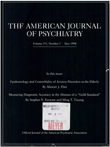Cigarette smoking in schizophrenia: relationship to psychopathology and medication side effects
Abstract
OBJECTIVE: The authors' goal was to study the relationship between smoking status and clinical characteristics in schizophrenic patients. METHOD: Seventy-eight schizophrenic outpatients were assessed by a single rater using the Brief Psychiatric Rating Scale (BPRS), the Abnormal Involuntary Movement Scale, and the Simpson-Angus Scale for extrapyramidal symptoms. Current smokers (N = 58) were compared with nonsmokers (N = 20) on clinical variables by independent t tests and chi-square tests. Differences in outcome variables were tested by multiple analysis of covariance (ANCOVA) with smoking status and gender as factors and age, neuroleptic dose, and caffeine consumption as covariates. RESULTS: Seventy-four percent of patients were current smokers and reported a mean of 19 cigarettes smoked per day. Compared to nonsmokers, current smokers were significantly more likely to be men, to be younger, and to have had an earlier age at onset and a greater number of previous hospitalizations. Current smokers and nonsmokers received mean neuroleptic doses of 1160 and 542 mg/day (chlorpromazine equivalents); the difference was significant. Current smokers also displayed significantly less parkinsonism and more akathisia and had higher total scores on the BPRS. Overall multiple ANCOVA demonstrated a significant main effect for smoking status but not gender or the interaction between gender and smoking status. Univariate ANCOVAs demonstrated a significant main effect of smoking status only for the Simpson-Angus Scale score. CONCLUSIONS: Cigarette smokers receive significantly higher neuroleptic doses, in part because of a smoking-induced increase in neuroleptic metabolism. Smoking is also associated with significant reduction in levels of parkinsonism. Smoking status is a significant factor that should be considered in assessment of neuroleptic dose requirements and neuroleptic side effects.
Access content
To read the fulltext, please use one of the options below to sign in or purchase access.- Personal login
- Institutional Login
- Sign in via OpenAthens
- Register for access
-
Please login/register if you wish to pair your device and check access availability.
Not a subscriber?
PsychiatryOnline subscription options offer access to the DSM-5 library, books, journals, CME, and patient resources. This all-in-one virtual library provides psychiatrists and mental health professionals with key resources for diagnosis, treatment, research, and professional development.
Need more help? PsychiatryOnline Customer Service may be reached by emailing [email protected] or by calling 800-368-5777 (in the U.S.) or 703-907-7322 (outside the U.S.).



